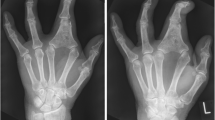Abstract
We report a 4-year-old boy with sclerosteosis associated with severe digital dysostosis. The initial medical consultation was prompted by bilateral, asymmetrical syndactyly of the index and middle fingers. The left index finger had complicated phalangeal anomalies: hyperphalangy (supernumerary phalanx distal to the middle phalanx) and hypoplasia with bracket epiphyses of the proximal and middle phalanges. Development of facial nerve palsy, hearing impairment and generalized osteosclerosis had occurred between 3 years and 4 years of age, with the subsequent identification of a homozygous SOST mutation. Bilateral second and third fingers syndactyly associated with abnormal patterning of the same fingers should be considered prodromal signs of sclerosteosis.









Similar content being viewed by others
References
Balemans W, Ebeling M, Patel N et al (2001) Increased bone density in sclerosteosis is due to the deficiency of a novel secreted protein (SOST). Hum Mol Genet 10:537–543
Brunkow ME, Gardner JC, Van Ness J et al (2001) Bone dysplasia sclerosteosis results from loss of the SOST gene product, a novel cystine knot-containing protein. Am J Hum Genet 68:577–589
de Paes Alves AF, Rubim JLC, Cardoso L et al (1982) Sclerosteosis: a marker of Dutch ancestry? Braz J Genet V:825–834
Cremin BJ (1979) Sclerosteosis in children. Pediatr Radiol 8:173–177
Leupin O, Piters E, Halleux C et al (2011) Bone overgrowth-associated mutations in the LRP4 gene impair sclerostin facilitator function. J Biol Chem 286:19489–19500
Holman SK, Daniel P, Jenkins ZA et al (2011) The male phenotype in osteopathia striata congenital with cranial sclerosis. Am J Med Genet A 155A:2397–2408
Chénier S1, Noor A, Dupuis L et al (2012) Osteopathia striata with cranial sclerosis and developmental delay in a male with a mosaic deletion in chromosome region Xq11.2. Am J Med Genet A 158A:2946–2952
Perdu B1, Lakeman P, Mortier G et al (2011) Two novel WTX mutations underscore the unpredictability of male survival in osteopathia striata with cranial sclerosis. Clin Genet 80:383–388
Acknowledgements
We cordially thank the patient and his family for participating in this study, and Professor Jürgen Spranger and Professor Christine Hall for their thoughtful comments.
Conflicts of interest
None
Author information
Authors and Affiliations
Corresponding author
Rights and permissions
About this article
Cite this article
Yagi, H., Takagi, M., Hasegawa, Y. et al. Sclerosteosis (craniotubular hyperostosis-syndactyly) with complex hyperphalangy of the index finger. Pediatr Radiol 45, 1239–1243 (2015). https://doi.org/10.1007/s00247-015-3292-1
Received:
Revised:
Accepted:
Published:
Issue Date:
DOI: https://doi.org/10.1007/s00247-015-3292-1




